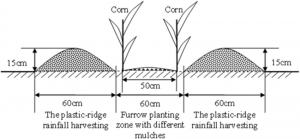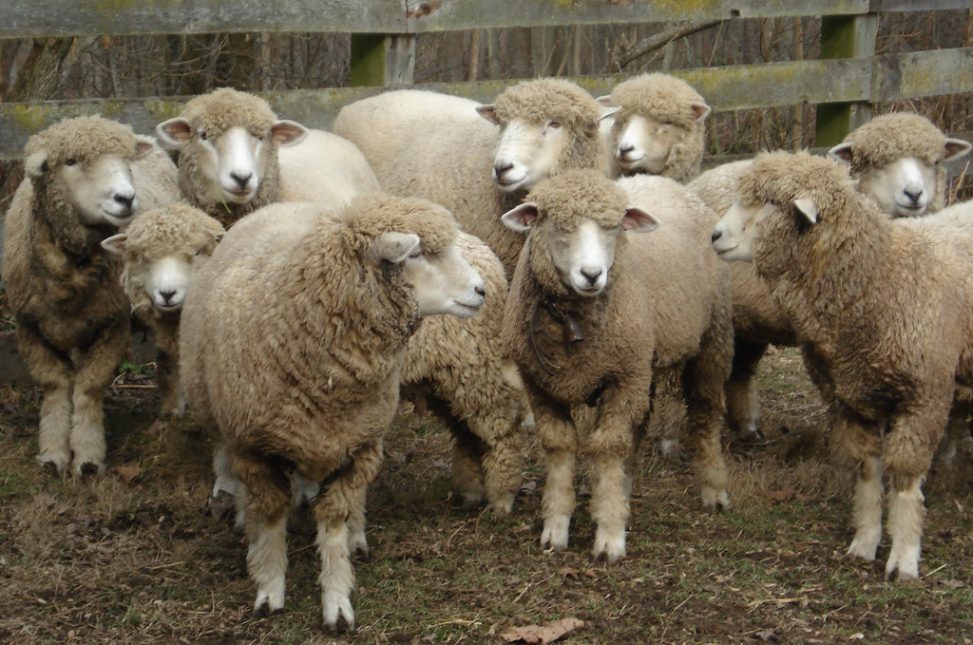Scientists in China have published research revealing the benefits of integrating animal manure into ridge and furrow planting systems. This research took place at the Dingxi Experimental Station of Gansu Academy of Agricultural Sciences, based in the Loess Plateau of northwest China. Agricultural operations in the Loess Plateau depend heavily on yearly rainfall patterns. Sixty-eight percent of rainfall in this area occurs between June and September, and about half of the rainfall events that occur can be classified as low rainfall events, meaning they result in less than 6mm of precipitation. Yields in rain-dependent areas like the Loess Plateau have been stagnating because of how unevenly rain is distributed, how extreme air temperatures can get, and loss of water from deep within the soil.
Ridge and furrow planting is a common planting pattern in this area of China and involves creating alternating steep and broad ridges in the soil and planting seeds in the furrows between these ridges. In this study, scientists investigated how the addition of

A diagram of ridge and furrow planting patterns, courtesy of researchgate.net
manure to small amounts of chemical fertilizers could help alleviate soil moisture loss, improve photosynthesis rates, and increase maize yields. Manure is believed to be an effective soil amendment for increasing yields because it contains large amounts of nitrogen-fixing bacteria that can help plants take advantage of the nitrogen that exists in the atmosphere.
In order to get a sense of how sheep manure can affect maize yields, scientists compared a variety of soil treatments combined with ridge and furrow planting systems. These treatments included 100% chemical fertilizer, 100% control-released fertilizer, 50% sheep manure combined with 50% chemical nitrogen, and finally flat planting with 100% chemical fertilizer. When all of the treatments were compared, it was found that the treatment containing 50% sheep manure had the greatest benefits by far. It resulted in greater yields, allowed the soil to store the most water, which is pivotal for this rain-dependent area, increased the rate at which the crops photosynthesized, and resulted in the greatest amount of dry matter.
The results of this study provide farmers in the Loess Plateau region with valuable information regarding how they should plant their crops and what kind of amendments they should add to their soils. The success of the inclusion of sheep manure is a big win for sustainable agriculture proponents because it means farmers can greatly reduce the amount of synthetics fertilizers that are added to the soil while also seeing the benefits of increased yields.
Article:
Qin, A. et al. 2019. Incorporation of manure into ridge and furrow planting systems boosts yields of maize by optimizing soil moisture and improving photosynthesis. Agronomy. 9, 865. https://www.mdpi.com/2073-4395/9/12/865

Alex
"This title was very eye catching! That is so interesting that such a ..."
Alex
"This is really interesting! The fact that crops and plants are damaged is ..."
Alex
"Well done, this article is great and the information is very captivating! Ethics ..."
Alex
"I was intrigued throughout the whole article! This is such an interesting topic, ..."
Alex
"This is such an interesting article, and very relevant!! Great job at explaining ..."
Grandpa
"Honey You Did a good job I will forward to my eye doctor "
murphymv
"This article is fascinating because it delves into the details of the research ..."
murphymv
"I agree, adding the photo helped solidify the main finding. "
murphymv
"This is a fascinating finding. I hope this innovative approach to improving transplants ..."
Sherzilla
"This is a great article! I would really love to hear how exactly ..."
Sherzilla
"It's disappointment that these treatments were not very effective but hopefully other researchers ..."
Sherzilla
"I agree with your idea that we need to shift our focus to ..."
Sherzilla
"It's amazing to see how such an everyday household product such as ..."
Lauren Kageler
"I will be interested to see what the data looks like from the ..."
Lauren Kageler
"A very interesting article that emphasizes one of the many benefits that the ..."
maricha
"Great post! I had known about the plight of Little Browns, but I ..."
Sherzilla
"I assumed cancer patients were more at risk to the virus but I ..."
Sherzilla
"Great article! It sheds light on a topic that everyone is curious about. ..."
maricha
"This article is full of really important and relevant information! I really liked ..."
maricha
"Definitely a very newsworthy article! Nice job explaining the structure of the virus ..."
maricha
"It's interesting to think that humans aren't only species dealing with the global ..."
murphymv
"This is very interesting and well explained. I am not too familiar with ..."
Lauren Kageler
"Great article! This post is sure to be a useful resource for any ..."
Lauren Kageler
"Definitely seems like an odd pairing at first, but any step forward in ..."
murphymv
"What an interesting article! As you say, height and dementia seem unrelated at ..."
murphymv
"Great article! I learned several new methods of wildlife tracking. This seems like ..."
murphymv
"Very interesting topic! You explained cascade testing and its importance very well. I ..."
Alex
"This article is really interesting! What got me hooked right away was the ..."
Sabrina
"I found this article super interesting! It’s crazy how everyday products can cause ..."
Erin Heeschen
"I love the layout of this article; it's very eyecatching! The advancements of prosthetics ..."
murphymv
"Awesome article! I like the personality in the writing. Flash Graphene not only ..."
murphymv
"Very interesting work! I don't know a whole lot about genetics, but this ..."
Cami Meckley
"I think the idea of using virtual reality technology to better help prepare ..."
Erin Heeschen
"I wonder if there's a connection between tourist season and wildfires in the ..."
Ralph berezan
"Not bad Good work "
Michelle
"This sounds like it would be a great tool for medical students! ..."